As I have covered in the first four parts of this History of the Snowmobile Series, there were many attempts at building snow traveling vehicles in the first half of the twentieth century. Some worked, some failed, and others just never caught on. The Bosak Power Toboggan snowmobile legacy made a significant impact in the evolution of the snowmobile. Most of you are probably thinking “I’ve never heard of them” and there’s a good reason for that.
The Bosak Power Toboggan was hand built from 1950 – 1965 in very limited numbers. Some claims are that there were up to fifty per year, others are 20 – 30 per year, and one claim put the total of around two-hundred built. No matter, they are rare.
The Bosak Power Toboggan Snowmobile Legacy
A man named Mike Bosak from a small town north of Beausejour, Manitoba, Canada called Brokenhead, had read about the snow traveling vehicles that had been built by J. Armand Bombardier and Carl Eliason. Bosak, a farmer and cabinet maker by trade, had an idea that he could build a similar vehicle to help the local trappers and hunters to haul their catch out of the deep woods north of Beausejour. So, in 1947 he decided to start working on that idea.
In an interview on YouTube, Bob Krawchuk, the grandson of Mike and Jessie Bosak, told the story of his grandmother recounting Mike’s earliest attempt. His first idea was to build a snow plane, of sorts. With money being tight, Mike bought a table at auction for 25 cents, and cut the legs off to mount skis underneath.
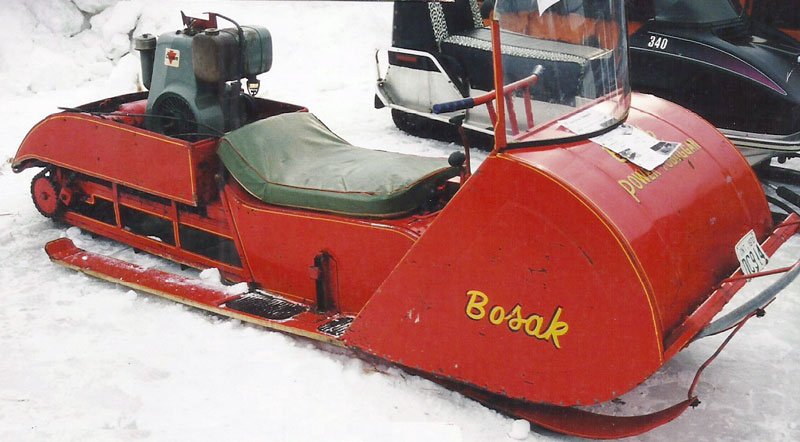
He then mounted a small Briggs & Stratton engine on top of it. Mike was working on a hand carved propeller for the engine, but soon decided that air power would not be practical and started to experiment with track drive instead. There is no mention of what happened to the table sled.
Husband and Wife Argue Over Snowmobile
Due to the lack of money, Mike worked on his invention in his workshop, hidden from Jessie. When he would hear her heading over to the barn, with her milk pails clinking, he would hide his contraption under the work bench.
One day while on her way out to the barn, Jessie decided to see why there was little income from cabinet sales lately, so she set down the pails and quietly went over to the workshop to check on him. She opened the door to the shop to find Mike working on his toboggan.
A heated argument over the sled ensued, but after some convincing by Mike, Jessie agreed to at least see what the toboggan would do. This first toboggan had a track running over wooden dowels, and was powered by the Briggs & Stratton engine that was bought for the air sled.
The toboggan was dragged out of the shop and Mike started to show Jessie what it could do; in a cloud of smoke and snow dust the sled moved 150 feet and came to a halt with a clank. Mike got his horses hooked up and dragged the sled back to the workshop for further revisions.

Bosak Power Toboggan Prototype and Production
During the Winter of 48-49 Mike had completed a fully working prototype. Jessie and their children were rounded up for test rides, the Power Toboggan was a success. The following winter Mike hired some help and started production of his Power Toboggan. One of the workers that Mike hired was Steve Krawchuk, who would later become the Bosak’s son-in-law.
The Bosak Power Toboggan snowmobile legacy reveals that Bosak production consisted of three employees and Mike. Sometime in the mid-1950s Mike was offered financial backing to produce the Bosak in higher volume, but he declined so that he could maintain control of quality and design.
Bosak Super M Snowmobile
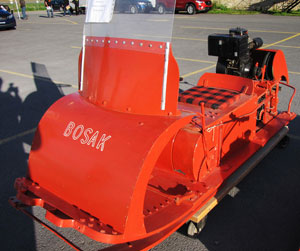
The first model was called the Bosak Super M, and was powered by a 9 HP Clinton engine, which was rear-mounted on steel framework, but the toboggan was made primarily out of wood. The Super M sold for $695 (Canadian currency).
By the end of 1950, three models were offered: the Super M-100 with a 10 HP engine and automatic transmission sold for $895, the Super M-200 with a 10 HP engine and three speed transmission for $995, and the Super M-300, considered the deluxe model, with a 36 HP Volkswagen engine for $1495. An optional 40 HP VW engine was available for an extra charge.
The first major design change was made in 1953 when the Power Toboggans were made of metal instead of wood.
A Ford three-speed transmission with reverse was added to the sled. A slide rail system was used to pull the engine forward to tighten the drive belts, replacing the previous double-belt drive system, which had used an idler pulley that was engaged to tighten the belts against the clutches to propel the sled.
In 1952 Bosak had started using Briggs & Stratton engines during production. It is unclear if this was to replace the Clinton engines, although, some later models did have Clinton engines, so probably not. The basic design of the Bosak Power Toboggan remained primarily the same into the ‘60s, with a few minor cosmetic changes.
The Bosak Power Toboggan Snowmobile Mustang
After 1960 it becomes unclear what models were produced, and in what years. The history of the Bosak Power Toboggan includes a design change on the Super M models. This included an engine cover, as well as a styling change to the cab, which included twin headlights.
Another model was introduced in the early ‘60s called the Mustang, this would be the new workhorse. It consisted of a tractor-style chassis with the engine center-mounted, a single wide track, removable handlebar mounted windshield, and a tow sled to carry cargo or passengers.

The Mustang was available with either a 9 HP or 7 HP engine. The last production model offered was the 1965 Super M-300, it had a generator, electric starter, headlights, and a 36 HP Volkswagen engine for $1895, and an optional 40 HP engine.
A brochure was published for a 1966 model called the Wild Cat, this was to be a more conventional styled snowmobile, with a forward mounted engine, two skis, single track, and passenger seating over the track. The brochure claimed a 372cc engine and a price of $895. Unfortunately, it did not go into production.
Bosak and the Canadian Power Toboggan Championships
The Lions Club in Beausejour was planning a winter “Blow Out” Carnival to be held in February 1962 to raise spirits during the long north winter. A member of the committee suggested using Mike Bosak’s Power Toboggans for a race during the carnival. The idea was well received.
During this first winter carnival, six power toboggans raced around hay bales in the local school yard at speeds up to 15 miles per hour. The crowd loved it. After the race, dozens of spectators test drove the machines around the track. The event was a huge success.
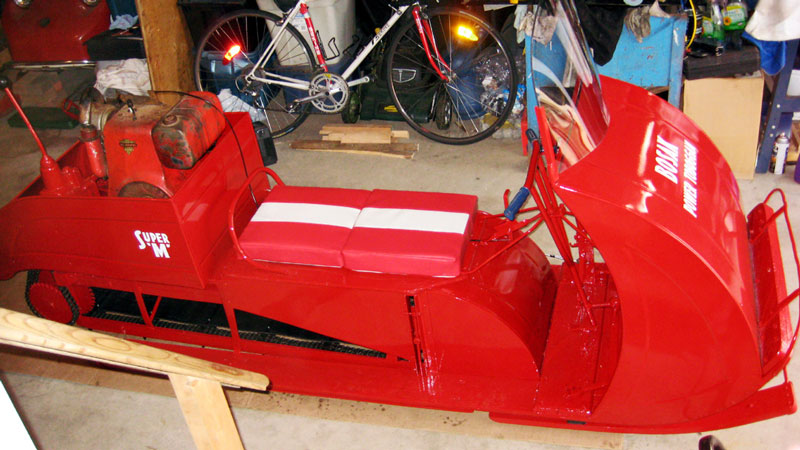
The next year the Lions Club decided to hold the race again, formally calling it the Canadian Power Toboggan Championships, and billing it as the main event at the carnival. Fifteen drivers attended the 1963 races’ main feature, then there were two exhibition races, one for women only. They raced as hard as the men. The race was such a success, that it has become a yearly event, growing exponentially over the years.
The race is considered to be the oldest snowmobile race in the world and is still the premier snowmobile race in Canada. Every year thousands of spectators are drawn to the half-mile oval track in Beausejour, to watch hundreds of drivers race in dozens of classes.
Bosak Power Toboggan Snowmobile Legacy Continues
Even though the Bosak Power Toboggan was not a big sales success, and hasn’t been produced in decades, the race it inspired still lives on. Not a bad legacy for a snowmobile that started in the workshop of a cabinet maker.
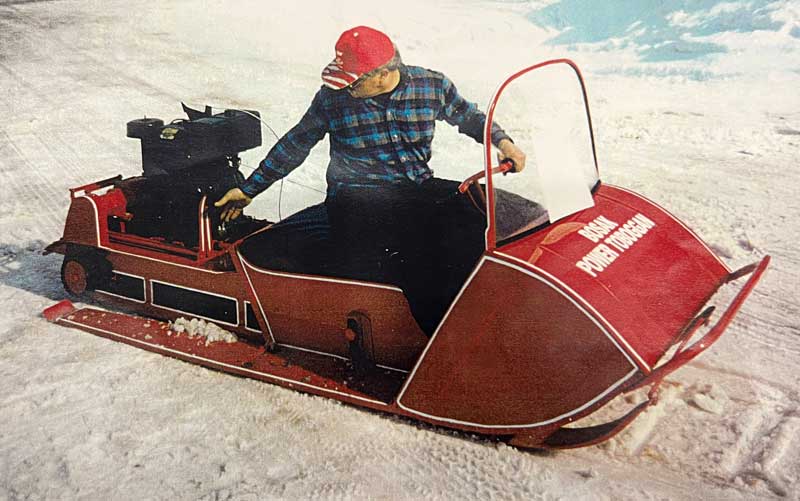
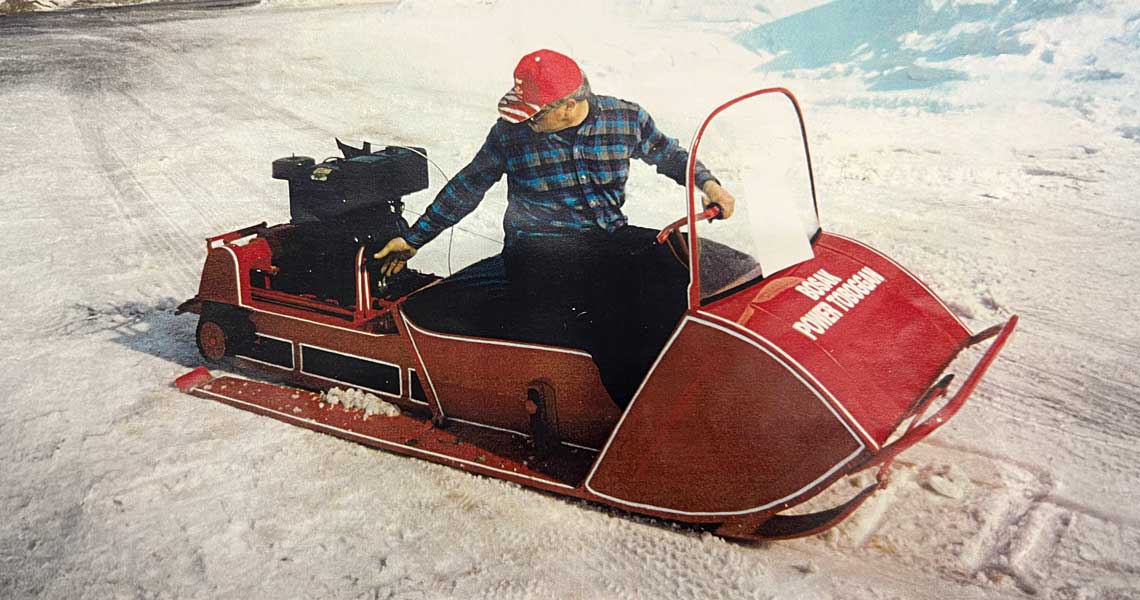
You must be logged in to post a comment.